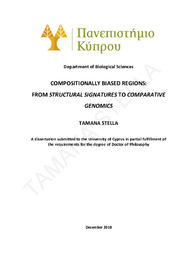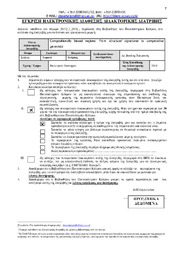| dc.contributor.advisor | Promponas, Vasilis | en |
| dc.contributor.author | Tamana, Stella A. | en |
| dc.coverage.spatial | Cyprus | en |
| dc.creator | Tamana, Stella A. | en |
| dc.date.accessioned | 2020-12-10T05:27:52Z | |
| dc.date.available | 2020-12-10T05:27:52Z | |
| dc.date.issued | 2018-12 | |
| dc.date.submitted | 2018-12-28 | |
| dc.identifier.uri | http://gnosis.library.ucy.ac.cy/handle/7/61705 | en |
| dc.description | Includes bibliographical references (p. 181-207). | en |
| dc.description | Number of sources in the bibliography: 373 | en |
| dc.description | Thesis (Ph. D.) -- University of Cyprus, Faculty of Pure and Applied Sciences, Department of Biological Sciences, 2018. | en |
| dc.description | The University of Cyprus Library holds the printed form of the thesis. | en |
| dc.description.abstract | Οι Περιοχές Ακραίας αμινοξικής Σύστασης (ΠΑΣ) αναφέρονται σε τμήματα κατά μήκος πρωτεϊνικών αλληλουχιών, όπου η σύστασή τους ευνοεί ένα/λίγα αμινοξικά κατάλοιπα. Οι ΠΑΣ βρίσκονται σε αφθονία σε όλους τους οργανισμούς και συχνά συσχετίζονται άμεσα με συγκεκριμένα δομικά πρότυπα, με εμφανείς συνέπειες στη (δυσ)λειτουργία των πρωτεϊνών. Επιπλέον, οι αιτιολογικοί παράγοντες της μαλάριας, τα παρασιτικά πρωτόζωα του γένους Plasmodium, παρουσιάζουν ασυνήθιστα υψηλή συχνότητα εμφάνισης ΠΑΣ, λόγω των εμπλουτισμένων γονιδιωμάτων τους σε Αδενίνη και Θυμίνη. Τα εξαιρετικά εμπλουτισμένα γονιδιώματα των παρασίτων της μαλάριας προκαλούν επιπρόσθετες τεχνικές προκλήσεις για τον προσδιορισμό της αλληλουχίας του γονιδιώματος, την κλωνοποίηση σε συστήματα ετερόλογων φορέων και απαιτούν ειδική μεταχείριση σε βασικά στάδια της συγκριτικής γονιδιωματικής. Επιπρόσθετα, ο περίπλοκος κύκλος ζωής των Πλασμωδίων ταξινομεί τα είδη αυτά ως εξαιρετικά πολύπλοκους οργανισμούς για την διεξοδική μελέτη της βιολογίας τους in vivo. Ωστόσο, ο αυξημένος αριθμός των Πλασμωδίων με πλήρη αλληλουχία γονιδιώματος, τα καθιστά σαν ιδανικό είδος για υπολογιστικές μελέτες σχετικά με το ρόλο των ΠΑΣ στην παθογένεια και την εξελικτική συμπεριφορά αυτών και άλλων ειδών με ΠΑΣ.
Η παρούσα μελέτη περιστρέφεται γύρω από τρία βασικά χαρακτηριστικά των ΠΑΣ: (i) πως οι ΠΑΣ επηρεάζουν τους υπολογισμούς κατά την ανάλυση παν-γονιδιωμάτων, (ii) τον ρόλο των ΠΑΣ στην εξελικτική συμπεριφορά των εξεταζόμενων πρωτεϊνικών οικογενειών, και (iii) τις δομικές υπογραφές των ΠΑΣ. Για την διεξαγωγή της παρούσας μελέτης χρησιμοποιήσαμε σύνολα δεδομένων που ανακτήθηκαν από ειδικευμένες βάσεις δεδομένων και αναπτύξαμε νέες υπολογιστικές διαδικασίες για την απάντηση των παραπάνω ερωτημάτων.
Τα αποτελέσματα μας υποδεικνύουν ότι η προκύπτουσα δομή του παν-γονιδιώματος των Πλασμωδίων εξαρτάται σε μεγάλο βαθμό από τις διαφορετικές στρατηγικές που χρησιμοποιήσαμε για την ανίχνευση των ΠΑΣ. Επιπρόσθετα, βασιζόμενοι τόσο σε στατιστική αλλά και βιολογικής σημαντικότητας ανάλυση, προτείνουμε μια βέλτιστη στρατηγική για συγκριτική γονιδιωματική παν-γονιδιώματων με υψηλό περιεχόμενο ΠΑΣ.
Κατά την παραπάνω συγκριτική γονιδιωματική ανάλυση, ανακαλύψαμε ευρήματα που αμφισβητούν την ευρέως διαδεδομένη αντίληψη ότι μόνο τέσσερις από τις οχτώ υπό-μονάδες του συμπλόκου OST -που θεωρείται διατηρημένο σε όλους τους ευκαρυωτικούς οργανισμούς- είναι παρούσες στα Πλασμώδια και άλλα πρώτιστα. Είναι αξιοσημείωτο, ότι ο κύριος λόγος για τον οποίο η ασυνήθιστα βραχεία πρωτεΐνη Ost4 (36 κατάλοιπα στους ζυμομύκητες) δεν είχε εντοπιστεί μέχρι στιγμής, είναι η αποτυχία των υπολογιστικών μεθόδων πρόβλεψης γονιδίων για την ανίχνευση μιας τέτοιας μικρής κωδικής αλληλουχίας. Στην πραγματικότητα, έχουμε σαφή ένδειξη με βάση ομοιότητες αλληλουχιών αλλά και επιπλέον υποστήριξη από δεδομένα έκφρασης (EST, RNAseq) ότι όλες οι υπό-μονάδες του συμπλέγματος OST (με εξαίρεση την υπὀ-μονάδα Swp1/Ribophorin II), μπορούν να ταυτοποιηθούν με αξιόπιστο τρόπο στα Πλασμώδια, αλλάζοντας την καθιερωμένη αντίληψη για την εξέλιξη του συμπλόκου OST και ανοίγοντας νέες κατευθύνσεις για την κατανόηση της πιθανής βιολογικής σημασίας του μηχανισμού της Ν-γλυκοζυλίωσης στα πρωτόζωα.
Παράλληλα, χρησιμοποιήσαμε αντίστροφη μηχανική και κατηγοριοποίηση για την χαρτογράφηση της αλληλουχίας των ΠΑΣ σε πειραματικά λυμένες πρωτεϊνικές δομές. Εστιάσαμε σε ΠΑΣ πλούσιες σε γλουταμικό και ασπαρτικό οξύ, όπου επανειλημμένα ομαδοποιούνται με βάση ανεξάρτητα κριτήρια, συζητώντας πιθανούς βιολογικούς τους ρόλους. Ενώ οι περισσότερες πρωτεϊνικές δομές κατατάσσονται λειτουργικά είτε ως πρωτεΐνες μεταφοράς ή ένζυμα, παρατηρήθηκαν επίσης ορισμένες επιπλέον κατατάξεις, όπως τοξίνες, πρωτεΐνες της απόπτωσης και κυτταρικής προσκόλλησης. | el |
| dc.description.abstract | Compositionally biased regions (CBRs) refer to spans along protein sequences with composition favoring one or a few residue types. CBRs are ubiquitous and are quite often directly related to specific structural patterns, with apparent implications in protein (dys-)function and interactions.
Plasmodium species, the causative agents of malaria, have an unusual high incidence of CBRs owing to their enriched A+T genomes. The extremely biased genomes of malaria parasites induce additional technical challenges for genome sequencing projects, cloning in heterologous vector systems and require special treatment in fundamental steps of comparative genomic analyses. Additionally, the complicate life cycle of Plasmodium species classifies these species as very complex organisms to thoroughly study their biology in vivo. However, the increased number of fully sequenced Plasmodium genomes makes it the ideal taxon for in silico studies of the role of CBRs in pathogenicity, their evolutionary behavior and to evaluate strategies for handling CBRs in pan-genome analysis in the present of extreme CBR-content.
The current thesis revolves around three main aspects of CBRs: (i) how CBRs affect the computation of heavily biased pan-genomes, (ii) the role of CBRs in evolutionary behavior of the protein families under study, and (iii) CBR preferences in structural conformations. We used carefully compiled datasets of Plasmodium species and non-redundant protein chains retrieved from the PlasmoDB and the Protein Data Bank. Furthermore, we developed novel computational pipelines for CBR detection and masking, sequence comparison/clustering, as well as structural feature computation.
Our results indicate that our view of the plasmodial pan-genome structure is largely dependent on the different strategies used to handle CBRs. We further propose an optimal strategy for comparative genomic analyses based on thorough statistical and biological assessment.
Our comparative genomics data led us to challenge the currently established notion that only 4 out of 8 subunits of the oligosaccharyltransferase (OST) complex –which is considered conserved across eukaryotes– are present in Plasmodium species and other protists. Remarkably, the main reason why the unusually short Ost4 protein (36 amino acid residues in yeast) has not been identified so far is the failure of gene-prediction pipelines to detect such a short coding sequence. In fact, based on carefully conducted sequence comparisons we provide unequivocal evidence that all components of the OST complex, with the exception of Swp1/Ribophorin II, can be reliably identified within completely sequenced plasmodial genomes. Importantly our findings are further supported by publicly available EST and RNAseq expression data.
Finally, a reverse engineering approach was followed for mapping sequence and structural signatures of CBRs in experimentally 3D solved protein structures. Specifically, our results portrayed both the structural preferences of CBRs and the sequence features these CBRs possess. We focus on D-/E-rich CBRs, which consistently are sub-clustered across the structure-based clustering, discussing their possible biological roles. Most such protein structures are classified as protein binding, transport proteins or enzymes; notably, some additional classifications, such as toxins, apoptosis and cell adhesion, were also observed. | en |
| dc.format.extent | xx, 220 p. : col. ill., diagrs. ; 30 cm. | en |
| dc.language.iso | eng | en |
| dc.publisher | Πανεπιστήμιο Κύπρου, Σχολή Θετικών και Εφαρμοσμένων Επιστημών / University of Cyprus, Faculty of Pure and Applied Sciences | |
| dc.rights | info:eu-repo/semantics/openAccess | en |
| dc.rights | Open Access | en |
| dc.subject.lcsh | Plasmodium | en |
| dc.subject.lcsh | Bacterial proteins | en |
| dc.subject.lcsh | Proteins – Structure | en |
| dc.subject.lcsh | Glycosylation | en |
| dc.subject.lcsh | Genomics | en |
| dc.title | Compositionally biased regions : from structural signatures to comparative genomics | en |
| dc.title.alternative | Περιοχές ακραίας αμινοξικής σύστασης: από δομικές υπογραφές σε συγκριτική γονιδιωματική | el |
| dc.type | info:eu-repo/semantics/doctoralThesis | en |
| dc.contributor.committeemember | Γεωργιάδης, Παντελής | el |
| dc.contributor.committeemember | Κυρμίζης, Αντώνης | el |
| dc.contributor.committeemember | Αμούτζιας, Γρηγόριος | el |
| dc.contributor.committeemember | Παυλόπουλος, Γεώργιος | el |
| dc.contributor.committeemember | Georgiades, Pantelis | en |
| dc.contributor.committeemember | Kirmizis, Antonis | en |
| dc.contributor.committeemember | Amoutzias, Grigoris | en |
| dc.contributor.committeemember | Pavlopoulos, Georgios | en |
| dc.contributor.department | Τμήμα Βιολογικών Επιστημών / Department of Biological Sciences | |
| dc.subject.uncontrolledterm | COMPOSITIONALLY BIASED REGIONS | en |
| dc.subject.uncontrolledterm | PANGENOME ANALYSIS | en |
| dc.subject.uncontrolledterm | PLASMODIUM | en |
| dc.subject.uncontrolledterm | PROTEIN STRUCTURE | en |
| dc.subject.uncontrolledterm | UNIQUE/ORPHAN GENES | en |
| dc.subject.uncontrolledterm | OLIGOSACCHARYLTRANSFERASE COMPLEX | en |
| dc.subject.uncontrolledterm | N-LINKED GLYCOSYLATION | en |
| dc.subject.uncontrolledterm | COMPARATIVE GENOMICS | en |
| dc.identifier.lc | QP551.T36 2018 | en |
| dc.author.faculty | Σχολή Θετικών και Εφαρμοσμένων Επιστημών / Faculty of Pure and Applied Sciences | |
| dc.author.department | Τμήμα Βιολογικών Επιστημών / Department of Biological Sciences | |
| dc.type.uhtype | Doctoral Thesis | en |
| dc.rights.embargodate | 2021-12-28 | |
| dc.contributor.orcid | Promponas, Vasilis [0000-0003-3352-4831] | |
| dc.contributor.orcid | Tamana, Stella A. [0000-0002-3414-4972] | |
| dc.gnosis.orcid | 0000-0003-3352-4831 | |
| dc.gnosis.orcid | 0000-0002-3414-4972 | |


